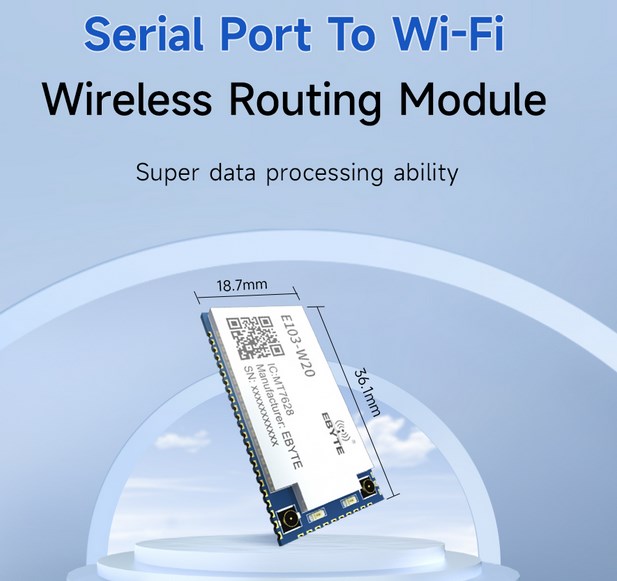

As wireless networks continue to grow in importance in our daily lives, we often need to ensure we have strong WiFi signal coverage in our homes, offices, or other locations. WiFi wireless network deployment is a crucial task to ensure that we can have a stable connection to the Internet everywhere without being affected by weak signals or dead zones.
ARTICLE OUTLINE :
Basic knowledge of wifi signals
The essence of WiFi signals is electromagnetic waves, which expand outward in a circular shape (such as water ripples splashed by a stone). The longer the wavelength and the lower the frequency, the lower the energy contained, but the stronger the diffraction ability, and the smaller the signal loss and attenuation; the shorter the wavelength and the higher the frequency, the higher the energy contained, but the weaker the diffraction ability. The greater the signal loss, the greater the attenuation.

2.4GHz and 5GHz WiFi signals are complementary. 2.4G WiFi(Related article :Ebyte wireless communication module based on 2.4G wireless Internet of Things application in the judge's station) has stronger wall penetration and diffraction capabilities, while 5G WiFi has weak wall penetration and diffraction capabilities but high frequency and large bandwidth.
WiFi signal strength is amplified and superimposed by the energy emitted by the transmitting device and the gain antenna. my country stipulates that the maximum transmit power of WiFi equipment is 100mW (20dBm), and the gain antenna is 5dBi~7dBi. When the transmitting power is the same, the signal transmitted by the 3dBi gain antenna appears in a semicircular shape similar to "()", and the signal transmitted by the 5dBi gain antenna appears in an elliptical shape similar to "<>".
The impact of dBi on wireless networks
When the wireless transmission power of the router is the same,
The larger the dBi value, the higher the gain, the smaller the vertical angle, and the longer the transmission distance, but the short-range transmission area is smaller;
The dBi value is small, the smaller the gain, the higher the vertical angle. Although the transmission distance is not far, the radiation area at close range is relatively larger;
WiFi signals will slowly attenuate when propagating in the air. The strength of the wireless signal at a certain point in space = transmitted signal strength - intermediate attenuation. In an open scene, the WiFi signal strength can maintain high quality within a radius of 200 meters, but in most life scenes, it can only maintain high-quality signal strength within a range of 10 meters.
"Note: dBi is a unit used to express the gain of an antenna. It indicates the gain of the antenna relative to an ideal point source antenna. Antenna gain refers to the efficiency of an antenna in transmitting or receiving wireless signals in a specific direction. By comparing the radiation pattern of an actual antenna to that of an ideal point source antenna, a gain value can be derived, expressed in dBi units."
Common home wifi signal problems
WiFi signals belong to the wireless microwave frequency band. The diffraction ability of this frequency band is very weak and almost propagates in a straight line. Walls, decorations, furniture, ceilings, glass, water, etc. will greatly attenuate the WiFi signal.
The WiFi transmission power of portable terminal devices such as mobile phones, laptops, and iPads is very low, while the transmission power of wireless routers is much higher. So there is a situation where the mobile phone shows a strong WiFi signal but cannot access the Internet. This is because the mobile phone WiFi module has low transmit power and is unable to transmit the signal back.

Devices that access the Internet through WiFi need to go through a three-way handshake process before they can actually establish a connection and access the Internet. Therefore, if the signal is strong on one side, it will not be able to access the Internet. This is also the case with "remote association" that seeks far away. In this case, you need to disconnect the farther WiFi and reconnect to the nearest WiFi.
WiFi signals will be interfered by microwave ovens, refrigerators, RFID, phones, etc., so WiFi devices should be placed away from these devices. Channel interference is also one of the main reasons for poor WiFi signals. There are many WiFi signals around us, and they will interfere with each other. It is becoming more and more difficult to optimize the 2.4G channel. The 5G frequency band attenuates quickly enough to interfere with and pollute the nearby 5G signals, so it is recommended if the device supports it. Use 5G WiFi.
The impact of wireless AP on wifi signals
It is recommended to purchase new equipment that supports WiFi 6. The coloring mechanism of WiFi 6 can minimize the conflict of WiFi signals on the same or adjacent channels and avoid slowdown caused by interference from adjacent WiFi signals. In addition, WiFi6 also has MU-MIMO, OFDMA, TWT and other technologies to increase spectrum utilization and save power. Of course, all devices must support WiFi6.

If you want to significantly improve WiFi signal quality and coverage area, you can only increase the number of wireless APs.
"Note: Wireless AP (Access Point) is a network device used to establish and manage Wireless Local Area Network (WLAN). It acts as a repeater in a wireless network, allowing wireless devices (such as laptops, smartphones, tablets, etc.) to connect to a wired network or the Internet."
The wireless AP should be placed in a central location with no obstacles around it. Narrow areas such as weak current boxes and cabinets will cause the WiFi signal to be greatly attenuated. If the heat dissipation is not good, the network will easily freeze if the device overheats.
The wireless AP should not be too close to the load-bearing wall. The "Faraday cage" effect formed by the mesh steel bars of the load-bearing wall will cause weak or no WiFi signal in a large area behind the load-bearing wall.
Wireless AP installation is mainly based on ceiling suction, supplemented by wall hanging. Open office area ≤ 100㎡ and personnel density ≤ 30 people are equipped with 1 AP. Each room with solid partition walls is equipped with 1 AP. Rooms with lightweight frame partition walls adjacent to open office areas can be equipped with 1 AP every other room.
Imagine that you have a WiFi router in your home located in the living room on the first floor, but the signal in your bedroom is very weak. This is because the location of the router is not optimal. To improve this situation, place the router close to the center of the home, such as in a stairwell or hallway. This will ensure that the signal is evenly distributed to each room.
If you have a large home or office, a single WiFi router may not provide enough coverage. Consider adding a signal extender or repeater placed between the router and the area you need coverage to enhance signal coverage.
Let's say there are many other WiFi networks near your home. This can cause signal interference and make your network unstable. In this case, use your WiFi router's management interface to select a less-used channel to mitigate interference.
If your WiFi router has an adjustable antenna, you can try adjusting the direction of the antenna to get the best signal. For example, if your office is on one side of a router, pointing the antenna in that direction can boost the signal.
If you only need to cover a small area, you can reduce the signal strength of your WiFi router to reduce unnecessary interference. Conversely, for large spaces, increase signal strength to ensure coverage.
On your home network, make sure appropriate security settings, such as WPA3 encryption, are enabled to protect your network from unauthorized access.
If your WiFi device supports both 2.4GHz and 5GHz bands, choose the band that suits your needs. The 5GHz band is generally faster but has a shorter signal range.
Use a WiFi signal prediction tool to help you determine the best router or repeater location to maximize coverage and performance.
Last but not least, maintain your WiFi network regularly. Make sure all devices are functioning properly and update router firmware to ensure security and stability.
By considering the key factors above, you can create a high-performance, reliable, and stable WiFi wireless network, whether in your home, office, or other location. In today's hyper-connected world, a strong WiFi network is key to ensuring smooth work and entertainment.
Recommended popular wifi modules
Chengdu Ebyte is a leading company specializing in wireless communication solutions. Our core advantage lies in providing cost-effective and highly competitive WiFi series products. Wireless communications have become an integral part of modern society, and it is in this area that we provide our customers with reliable and efficient solutions. We sincerely recommend the following 2 wifi module models from the official website.
 ESP32-WROVER-IE uart serial port WiFi module
ESP32-WROVER-IE uart serial port WiFi module
[IP]:ESP32-D0WD-V3
[Frequency]:2.4~2.5GHz
[Protocol]:IEEE802.11b/g/n
[Distance]:400m
[Type]:UART I/O
[Features]:Universal Wi-Fi module
[Introduction]:ESP32-WROVER-IE is a
general-purpose Wi-Fi module with powerful functions, built-in
ESP32-D0WD-V3 chip, Xtensa® dual-core 32-bit LX6 microprocessor, 448 KB
ROM, 520 KB SRAM, 16 KB RTC SRAM supports up to 240 clock frequency in
MHz.
 MT7628AN chip solution Open Wrt operating
system and custom development patch type serial port to WiFi
wireless routing module
MT7628AN chip solution Open Wrt operating
system and custom development patch type serial port to WiFi
wireless routing module
[Chip solution]:MT7628AN
[WiFi protocol]:IEEE802.11b/g/n
[Transmission power]:20~24dBm
[MCU main frequency]:580MHz
[Communication distance]:200m
[Product size]:34.1*18.7*2.77mm/36.1*18.7*2.7mm
[Introduction]:E103-W20 (7628) module is a low-cost and low-power IoT module based on MediaTek MT7688AN and MT7628AN. This module leads to all interfaces of MT7688AN/MT7628AN, supports OpenWrt operating system and custom development, has rich interfaces and powerful processors, can be widely used in smart devices or cloud service applications, etc., and can be freely used for secondary development .








